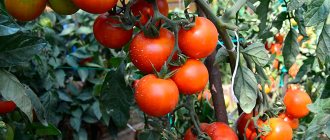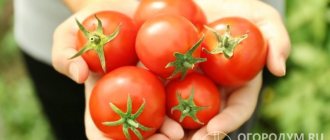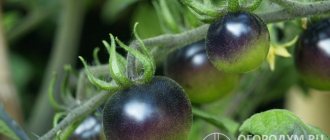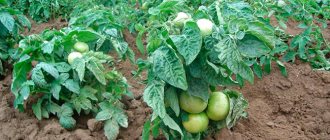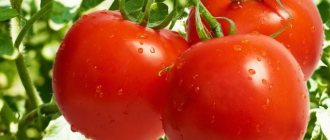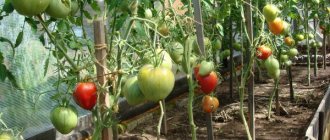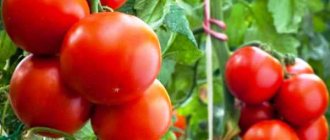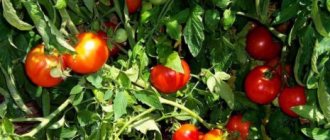Home / Vegetable garden / Tomatoes
Back
Published: 11/30/2020
4
Rate this post
Klusha tomatoes attract the attention of summer residents with their unusual name. Many people have the opinion that such a tomato, by definition, cannot disappoint. Practice shows that the early variety produces good harvests, while being unpretentious and easy to care for.
Bred by Siberian breeders, the tomato is suitable for regions of risky farming. The short “baby”, of course, cannot compete with giant indets in terms of productivity, but it gives tasty and, most importantly, early fruits.
- 1 Description of the variety
- 2 Characteristics of fruits
- 3 Advantages and disadvantages
- 4 Comparing tomatoes from the Siberian Garden
- 5 Features of cultivation 5.1 Sowing seeds and caring for seedlings
- 5.2 Approximate timing of planting on ridges
- 5.3 Nuances of agricultural technology
Description of the tomato variety Klusha
The creators of the variety are breeders Dederko and Postnikova. The original Klushi seeds were selected by agro for the first time.
Klusha is an early ripening variety. About 90 days pass from the emergence of seedlings to the ripening of tomatoes. The Klusha tomato variety is determinate; the height of its bushes usually does not exceed 60 cm. The plants are planted at a close distance to each other. A separate variety of the Klusha tomato variety is the Super Klusha tomato variety, which is distinguished by the pink color of the tomatoes, the height of the bushes at 30-40 cm and some other minor differences.
Important! The small size of the fruits of the Klusha variety (Super Klusha) allows you to grow tomatoes on the balcony.
The foliage of the bushes is of a regular shape, colored dark green. The number of leaves is usually large, especially in the Super Klusha variety. The inflorescences are simple, most often containing 8 flowers. 95% of them form the ovary and fruits.
Due to the fact that the bushes of the variety are low, they are cultivated without staking. Under the mass of numerous tomatoes, plants can bend to the ground. To prevent this from happening, it is recommended to install light supports for bushes on the site.
Description of fruits
Tomatoes of the Klusha variety are characterized by a round shape. The top of the tomatoes and the wall near the stalk attachment are slightly flattened. The color of tomatoes is deep red, while Super Klushi’s is pink. The pulp is very juicy and has a sweet, pleasant taste, especially when eaten fresh. Inside tomatoes there are about 7 chambers filled with seeds.
The weight of tomatoes is 150 g, subject to all agrotechnical recommendations. When cultivating the Klusha (Super Klusha) variety in a deviation from the rules, the tomatoes become smaller, their weight can be reduced to 100 g or less.
Tomatoes can be stored for a long time, but only if they were picked slightly unripe. Transportability is good.
Analogs
The table shows the comparative characteristics of the Klusha variety with other low-growing varieties.
| Variety name | Tomato ripening time | Bush height | Productivity | Fruit weight | Taste | Growing conditions |
| Broody | 90-95 days | 50-60 cm | In the garden -1.8-2.2 kg, in the greenhouse - 10-11 kg | 90-150 gr | Great | Open ground, greenhouse |
| Lady fingers | 110 days | 60-100 cm | In open ground - 2.7 kg per bush, in film cover - 15 kg | 52-70 gr | Good | In open ground, under film |
| Demidov | 100-108 days | 60-64 cm | 11 kg | 80-110 gr | Good | In the greenhouse and in the garden |
| Boni MM | 85-90 days | About 50 cm | From 5.5 kg to 6.5 kg | Good | Greenhouse, open ground | |
| Siberian Troika | 90-95 days | 50-60 cm | 6 kg | 80-100 gr | Great | Open ground |
| Nastenka | 105-110 days | 60-70 cm | 2-10 kg | 125-300 gr | Good | Greenhouse, open ground |
Characteristics of Klusha tomatoes
The variety has virtually no disadvantages. A small minus is the significant number of leaves. Tomatoes grown in shaded conditions have a slight sour taste.
Productivity and fruiting
One bush of the variety usually produces about 2 kg of fruit. Up to 11.5 kg of ripe tomatoes can be collected per 1 m2. They increase the productivity of the variety due to some agrotechnical techniques. For example, productivity increases if Klusha (Super Klusha) tomatoes are grown in 2-4 stems.
Area of application of fruits
The fruits of the tomato variety Klusha (Super Klusha) are universal in their purpose. Most often, they are used to make salads or use tomatoes to add to main dishes, decorating them. The resulting Super Klusha tomato fruits are also suitable for canning. Dense elastic pulp, covered with a durable peel, protects the inside of the fruit from cracking during heat treatments.
Resistance to diseases and pests
The Super Klusha tomato variety exhibits resistance to major tomato diseases. To maintain plant immunity at the proper level, it is necessary to follow agricultural cultivation techniques, in particular:
- remove weeds in a timely manner;
- do not over-moisten the soil;
- observe the dosage when applying fertilizing;
- loosen the soil.
For tomatoes, late blight is the most dangerous. This disease most often spreads in the second half of summer, while the fruits of Super Klushi develop in the first half. Among insect pests, the most dangerous for the variety is the Colorado potato beetle.
Advantages and disadvantages of the variety
According to the description of the Klusha and Super Klusha varieties, the positive characteristics of tomatoes include:
- relatively high plant productivity;
- versatility of fruit use;
- high winter hardiness;
- small size of bushes, compactness;
- no need to remove stepsons;
- resistance to major tomato diseases.
The positive reviews about the Klusha tomato posted below confirm the fact that the variety has virtually no serious drawbacks.
Pest and disease control
The Klusha tomato can be affected by gray rot, which appears as gray spots and plaque on the stems and then on the fruits. Copper sulfate helps.
To prevent gray rot, regularly ventilate the greenhouse, improve the acidity of the soil with ash or bone meal
Tomato Klusha may suffer from pests. One of the enemies is the Colorado potato beetle. In small quantities it can be collected by hand. Among the drugs that are effective are Actellik, Decis, Karate, Prestige.
The Colorado potato beetle, sensing danger, falls to the ground and pretends to be dead.
Another enemy of the crop is the whitefly. The insect is only 1.5-3 mm in length. Its signs are:
- whitish or yellowish spots that turn black over time;
- curling and wilting of leaves;
- slow ripening of fruits, white veins in the pulp.
Insecticides, infusions of garlic and tobacco help against whiteflies
A tomato can suffer from spider mites; its signs are small whitish or yellowish spots on the leaves, their curling, drying out, and falling off. Drugs like Actellica, Fufanon, Fitoverma will help. Infusions of calendula, onion peel, and garlic are effective.
To prevent spider mites, you need to disinfect the soil, burn plant residues, observe crop rotation, do not thicken plantings, and water the crop on time
Important! Compliance with crop rotation, deep digging of the soil and burning of plant residues are measures to prevent many problems in different crops.
Growing rules
The tomato variety in question can be grown both in open ground and in a greenhouse. However, without growing seedlings, seeds can be immediately planted in the ground only in the south of Russia. In the rest of our country, the seedling method is more preferable.
Planting seedlings
Sowing of seeds is carried out in March. For seedlings, select a store-bought soil mixture or soil prepared independently. In the latter case, it requires additional disinfection. To do this, the collected soil is calcined in the oven, then taken out into the open air for two weeks. During this period of time, the soil will accumulate oxygen.
Before sowing the seeds, the soil is transferred into the house to adapt to room conditions. At the same time, additional disinfection is carried out. To do this, dilute 1 g of manganese in 2 liters of clean water and mix the solution thoroughly, after which it is evenly poured onto the soil.
Seeds for sowing are first visually inspected, removing all small, diseased and deformed ones. Priority is given to the largest and healthiest specimens. Next, they are placed in a container with saline solution. The seeds that float to the surface of the liquid are collected and discarded, those that fall to the bottom are washed in clean water. After this, the material is disinfected: immersed in a 1% manganese solution for 20 minutes.
Important! Instead of potassium permanganate solution, you can use aloe juice.
Ready seeds need to be germinated. For this purpose, they are evenly laid out between two layers of moistened gauze and left in this position. The cloth should be moistened regularly to prevent the seeds from drying out.
When the Super Klusha tomato sprouts sprout from all the seeds, they are planted together. By this time, containers with soil should be prepared. On its surface, oblong grooves 1 cm deep are made with any available tool. A distance of approximately 2-3 cm is left between the resulting rows. Tomato seeds are evenly laid out in grooves every 3 cm. They are covered with loosened soil on top and sprayed with clean water.
The containers are covered with transparent plastic film to obtain a greenhouse effect. After this, the boxes are moved to a room with a constant air temperature of about +25C. In such conditions, the seedlings remain until shoots appear. After this, the film cover is removed and additional lighting is provided for the seedlings. When the plants form 2 true leaves, they are picked and placed in separate cups. This procedure is stressful for young plants, so 3 days after picking they need to be supported with fertilizing.
Tomato transplant
Before transplanting Klush tomato seedlings to a permanent place, they are first hardened off. When the temperature outside reaches +18C, the cups with seedlings are taken out into the fresh air. At first they are kept for a short time, but every day the duration of their stay on the street should increase. One week is enough for seedlings to harden normally. When the plants reach a height of 30 cm, you can begin replanting them in a permanent location. This usually happens on the 50-60th day of growing Super Klusha tomatoes (the first half of May).
When planting tomato seedlings, keep in mind that the soil must be sufficiently warmed up. The soil should first be loosened and saturated with nutrients. The Super Klusha tomato variety does not tolerate low soil acidity; neutral or slightly acidified soils are more preferable for it. Since the variety is determinant and does not grow in length, it is allowed not to deepen the roots. It is recommended to place up to 5 tomato bushes per 1 m2.
Subsequent care for tomatoes
The Super Klusha tomato variety is easy to care for. Irrigation directly under the root is carried out as the soil dries using warm, settled water. Watering is carried out in the morning or late in the evening to avoid plant burns from the sun's rays. You should not spray water on the surface of the foliage, as this will provoke the development of fungal diseases.
After each watering or precipitation, it is recommended to loosen the soil in the bite sector. This will saturate the root system with moisture and oxygen, which will accelerate its development. At the same time, weeds are removed.
Important! Super Klusha tomatoes are grown without pinching.
A few weeks after transplanting the seedlings, the plantings are treated with nitroammophos. 40 g of this drug is dissolved in a bucket of water. During the growing season, tomatoes are fed with mineral fertilizers twice more.
The ripe fruits of Super Klushi are picked without stalks and carefully laid out in pre-prepared boxes. Before storage, each tomato is wrapped in a soft paper sheet and placed in a box. Layered with sawdust or hay.
Care
Care includes creating mulch that will serve as a cushion for the fruits; if their weight becomes heavy on the stems and they fall to the ground, such a cushion will prevent them from being damaged.
All lower leaves that block the light source from the fruit should be trimmed.
To prevent plant disease, it is sprayed with protective agents against pests and diseases every 2 weeks.
Watering is done abundantly, you need to water at the root so that water does not get on the stems and leaves. There is no need to water the plant often.
general information
There is a huge selection of tomato seeds on the market for amateur gardeners and farmers: as they say: “Your eyes run wild.” So, what should we choose? How to find something worthwhile, because the harvest depends on the right variety, and it “feeds the year.”
In this abundance, among the low-growing representatives of the determinate type, the “Klusha” tomato stands out; reviews and photos of its yield are simply pleasing and inspiring.
This variety wins the hearts and gardens of summer residents with its friendly harvest, bright and even fruits.
Preparing soil for seedlings
In most regions, tomatoes are grown from seedlings. Only in the south is it possible to sow seeds directly into the garden bed. To grow Klusha or Super Klusha tomato seedlings, you first need to prepare the soil. Despite the saturation of store-bought soil with useful minerals, many vegetable growers prefer to collect soil from the garden for seedlings. You can do it this way, you just need to disinfect it. It is recommended to bake the soil in the oven and then take it out into the fresh air. Outside, the soil will be saturated with oxygen for two weeks.
Before sowing the seeds, the soil is brought into the house so that it warms up to room temperature. At this time, another disinfection is performed. A solution is prepared from 2 liters of water and 1 g of manganese and the soil is evenly moistened with this liquid.
